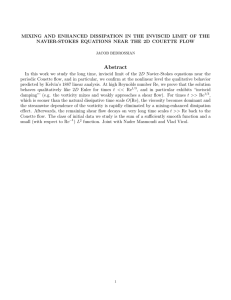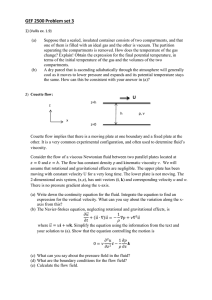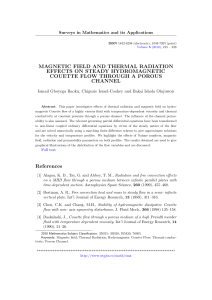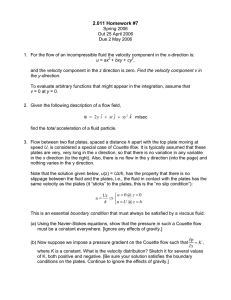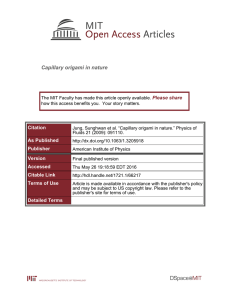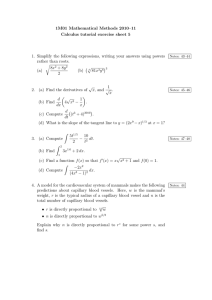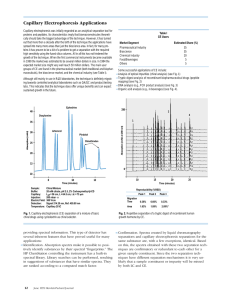Validation of new microvolume Couette flow linear dichroism cells
advertisement
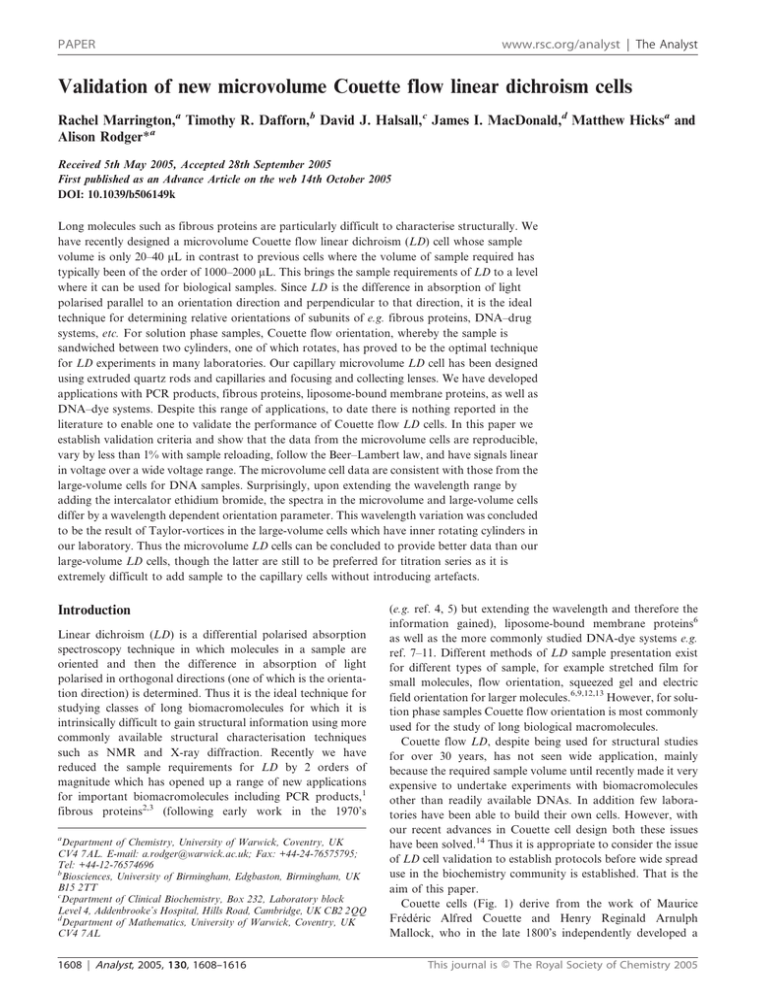
PAPER
www.rsc.org/analyst | The Analyst
Validation of new microvolume Couette flow linear dichroism cells
Rachel Marrington,a Timothy R. Dafforn,b David J. Halsall,c James I. MacDonald,d Matthew Hicksa and
Alison Rodger*a
Received 5th May 2005, Accepted 28th September 2005
First published as an Advance Article on the web 14th October 2005
DOI: 10.1039/b506149k
Long molecules such as fibrous proteins are particularly difficult to characterise structurally. We
have recently designed a microvolume Couette flow linear dichroism (LD) cell whose sample
volume is only 20–40 mL in contrast to previous cells where the volume of sample required has
typically been of the order of 1000–2000 mL. This brings the sample requirements of LD to a level
where it can be used for biological samples. Since LD is the difference in absorption of light
polarised parallel to an orientation direction and perpendicular to that direction, it is the ideal
technique for determining relative orientations of subunits of e.g. fibrous proteins, DNA–drug
systems, etc. For solution phase samples, Couette flow orientation, whereby the sample is
sandwiched between two cylinders, one of which rotates, has proved to be the optimal technique
for LD experiments in many laboratories. Our capillary microvolume LD cell has been designed
using extruded quartz rods and capillaries and focusing and collecting lenses. We have developed
applications with PCR products, fibrous proteins, liposome-bound membrane proteins, as well as
DNA–dye systems. Despite this range of applications, to date there is nothing reported in the
literature to enable one to validate the performance of Couette flow LD cells. In this paper we
establish validation criteria and show that the data from the microvolume cells are reproducible,
vary by less than 1% with sample reloading, follow the Beer–Lambert law, and have signals linear
in voltage over a wide voltage range. The microvolume cell data are consistent with those from the
large-volume cells for DNA samples. Surprisingly, upon extending the wavelength range by
adding the intercalator ethidium bromide, the spectra in the microvolume and large-volume cells
differ by a wavelength dependent orientation parameter. This wavelength variation was concluded
to be the result of Taylor-vortices in the large-volume cells which have inner rotating cylinders in
our laboratory. Thus the microvolume LD cells can be concluded to provide better data than our
large-volume LD cells, though the latter are still to be preferred for titration series as it is
extremely difficult to add sample to the capillary cells without introducing artefacts.
Introduction
Linear dichroism (LD) is a differential polarised absorption
spectroscopy technique in which molecules in a sample are
oriented and then the difference in absorption of light
polarised in orthogonal directions (one of which is the orientation direction) is determined. Thus it is the ideal technique for
studying classes of long biomacromolecules for which it is
intrinsically difficult to gain structural information using more
commonly available structural characterisation techniques
such as NMR and X-ray diffraction. Recently we have
reduced the sample requirements for LD by 2 orders of
magnitude which has opened up a range of new applications
for important biomacromolecules including PCR products,1
fibrous proteins2,3 (following early work in the 1970’s
a
Department of Chemistry, University of Warwick, Coventry, UK
CV4 7AL. E-mail: a.rodger@warwick.ac.uk; Fax: +44-24-76575795;
Tel: +44-12-76574696
b
Biosciences, University of Birmingham, Edgbaston, Birmingham, UK
B15 2TT
c
Department of Clinical Biochemistry, Box 232, Laboratory block
Level 4, Addenbrooke’s Hospital, Hills Road, Cambridge, UK CB2 2QQ
d
Department of Mathematics, University of Warwick, Coventry, UK
CV4 7AL
1608 | Analyst, 2005, 130, 1608–1616
(e.g. ref. 4, 5) but extending the wavelength and therefore the
information gained), liposome-bound membrane proteins6
as well as the more commonly studied DNA-dye systems e.g.
ref. 7–11. Different methods of LD sample presentation exist
for different types of sample, for example stretched film for
small molecules, flow orientation, squeezed gel and electric
field orientation for larger molecules.6,9,12,13 However, for solution phase samples Couette flow orientation is most commonly
used for the study of long biological macromolecules.
Couette flow LD, despite being used for structural studies
for over 30 years, has not seen wide application, mainly
because the required sample volume until recently made it very
expensive to undertake experiments with biomacromolecules
other than readily available DNAs. In addition few laboratories have been able to build their own cells. However, with
our recent advances in Couette cell design both these issues
have been solved.14 Thus it is appropriate to consider the issue
of LD cell validation to establish protocols before wide spread
use in the biochemistry community is established. That is the
aim of this paper.
Couette cells (Fig. 1) derive from the work of Maurice
Frédéric Alfred Couette and Henry Reginald Arnulph
Mallock, who in the late 1800’s independently developed a
This journal is ß The Royal Society of Chemistry 2005
Materials and methods
Design and construction of microvolume Couette LD cell
Fig. 1
Schematic diagram of LD Couette cell.
means to measure viscosity based on shearing a liquid between
coaxial cylinders.15–18 Since then there have been many
applications of the Couette principle within the engineering
and physics communities, the most notable example being that
of Taylor.19–21 Couette flow was developed further by Wada
and Kozawa in 1964 into an apparatus for UV dichroism
measurements.22 In the 1960’s–70’s, flow LD was recognised as
a useful technique and was used in the characterisation of
fibrous proteins such as actin as well as probing the orientation
of DNA and bound ligands.23–28 The limitations of instrument
design and technology with respect to the required sample
volume (1–2 mL) and spectrometer design made it difficult to
develop the technique further. Therefore Couette flow LD has
been mainly restricted in application to DNA and DNA–drug
systems as noted above.
The annular gap in Couette LD cells has typically been
y500 mm, though experiments using a 50 mm annular gap have
been reported2,5,6 which reduced the sample volume to 200 mL.
The sample volumes required are still too large for applications
such as analysis of PCR reactions, analysis of expensive
biological samples including membrane proteins in liposomes,
fibrous peptides, and proteins. This was the motivation for the
new cell design which has also been used to develop the new
technique of fluorescence detected flow LD13 and to study the
bacterial fibrous protein FtsZ.29 In this paper we report
experiments undertaken to show that the data from the new
design of LD cell which requires only 25 mL sample are
consistent with or better than those achieved with more
traditional LD cells. The limitations of the new cells are also
established.
Two microvolume Couette LD cells have been designed and
developed based on the same design, one being room
temperature use only and the other having a heated metal
jacket surrounding the capillary housing to enable steady-state
thermostatting. The key features of the design are the use of an
extruded quartz capillary (y5 mm outer diameter (o.d.) and
y3 mm inner diameter (i.d.)) as the outer rotating cylinder
(Fig. 1), and a centrally mounted extruded quartz rod (o.d.
dependent on annular gap and hence path length required,
typically y2.5 mm) as the inner stationary cylinder. The
capillaries and rods were supplied by Enterprise-Q,
Manchester, UK. The microvolume Couette LD cell was
designed and built in collaboration with Crystal Precision
Optics, Rugby, UK. The cell unit has been mounted on a base
plate that has been designed specifically for Jasco CD
spectropolarimeters with large sample compartments, though
modifications to small compartments and other instrument
bases are straightforward.
The main body of the microvolume Couette LD cell has
been manufactured from laboratory and food industry
specification stainless steel (Fig. 2). The bearings and drive
spindle are also made from stainless steel and are designed to
be dust and water resistant. The capillary units are demountable for removal during cleaning and sample loading. In this
work the capillaries are sealed at the base with Araldite
Rapid1 and held in position in the metal base unit by an
‘O’-ring. A motor is used to drive the ‘O’-ring and in turn the
capillary. This is controlled electronically by an EP-603
(0–30 V) power supply, adapted to allow more precise
measurements (two decimal places) of applied voltage by the
addition of a 10-turn potentiometer. A quartz rod is held
within a Teflon1 unit that is inserted into the metal lid. Before
operation, the complete lid unit is inserted into the capillary
and screwed securely into place (Fig. 2). This design enables
different diameter rods to be used within the microvolume
Couette cell.
Fig. 3(a) shows a photograph of the microvolume Couette
flow LD cell and Fig. 3(b) shows a schematic diagram of the
Fig. 2 (a) General arrangement drawing showing detail of quartz microvolume Couette flow LD cell and (b) schematic diagram showing the
capillary and rod assembly in the microvolume Couette LD cell.
This journal is ß The Royal Society of Chemistry 2005
Analyst, 2005, 130, 1608–1616 | 1609
Fig. 3 (a) Photograph of microvolume Couette flow LD cell and (b) schematic diagram of microvolume Couette flow LD cell. Normal use has the
detector on the right hand side; fluorescence-detected LD has the photomultiplier tube relocated to the top position.
unthermostatted cell (including the option for fluorescence
detection14). A 2.54 cm diameter 6 10 cm focal length
uncoated lens (supplier Edmund Optics1) is placed 10 cm in
front of the centre of the rod to ensure that the light is only
incident on the middle of the capillary; and a second postsample focusing lens (2.54 cm diameter 6 6 cm focal length) is
placed after the sample to focus the diverging light beam
onto the photomultiplier tube (this has the added advantage of
reducing the loss of light due to scattering by the large
molecules often present in the samples for LD experiments).
The base unit of the microvolume Couette LD cell has three
slideways to hold the lens holders and to enable them to be
finely adjusted by linear movements.
Thermostatted microvolume Couette LD cell
The thermostatted microvolume Couette LD cell is a development of the microvolume Couette LD cell, with the main
difference being the addition of a thermostatted metal jacket
with silicon rubber and fibreglass heater pads wrapped around
the capillary unit, a temperature probe and a controller. The
temperature controller was calibrated to allow the temperature
to be set within the operating range (room temperature to
y60 uC). Once a temperature has been programmed, the
controller will allow input current to the heater pad to raise the
temperature up to near this temperature. The temperature
probe is located on the top surface of the capillary unit, and
measures the temperature of the steel housing (note, this is not
the centre of the cell). When the preset temperature is close to
being achieved, the controller switches from a continuous
current input to an intermittent current input which holds the
set temperature to ¡0.2% of the set temperature. Higher
temperatures require a longer equilibration time. For example
in order to heat the capillary to 63 uC, the cell and temperature
unit had to be left for an hour and a half (Fig. 4). The motor
should be turned on during the equilibration period as the
heat generated from the motor causes a net temperature
increase in the sample of y3 uC, and this should be taken
into account when setting the temperature. For example if a
temperature of 37 uC is required the temperature controller
should be set to 34 uC.
Large-volume Couette LD cell
The large-volume 500 mm annular gap cells used for comparison purposes included the original one (LV Cell 1) from
1610 | Analyst, 2005, 130, 1608–1616
Fig. 4 The temperature of the thermocouple as a function of time
from switching on the heater in the thermostatted microvolume
Couette LD cell.
our laboratory, whose design is reported in ref. 12 and a more
recently designed version of this (LV Cell 2) where the outer
stationary cylinder is a quartz capillary held in place within a
stainless steel housing, with gaps for the light to pass through
the sample, and a central rotating quartz cylinder.
Experiments for validation of performance of Couette flow LD
cells
Calf thymus-DNA (ct-DNA highly lyophilised from Sigma)
was dissolved in high purity water (18.2 mV) and used for most
experiments summarised below. For investigating the larger
wavelength range, 750–200 nm, DNA–ethidium bromide
solutions were used at concentrations specified below. For
LV Cell 1 2000 mL and for LV Cell 2 1000 mL of sample were
used at a voltage of 2 V (unless otherwise stated). For the
microvolume Couette LD cell, samples were individually
prepared with volumes of 40 mL placed into the capillary
and a voltage of 4 V was used in all experiments, unless
otherwise stated. A Gilson air displacement pipette (P100) was
used for the loading of capillaries. Volumes of 25–60 mL can be
used in conjunction with a y2.5 mm outer diameter rod. A
Jasco J-715 with large sample compartment that has been
adapted for LD measurements was used for all LD experiments. Instrumental parameters for experiments with ct-DNA
alone and ct-DNA–ethidium bromide, in both full wavelength
(spectrum measurement) and kinetics (time course measurement) are given in Table 1.
This journal is ß The Royal Society of Chemistry 2005
Table 1 Parameters used on the Jasco J-715 spectropolarimeter for
both wavelength scanning measurements and time course measurement. Parameters in parentheses were those used for calculation of
revolutions per minute (rpm) for the microvolume Couette LD cell
Spectrum measurement
Wavelength/nm
Scanning speed/nm min21
Response/s
Data pitch/nm
Band width/nm
No. of accumulations
Time course measurement
Time/s
Response/s
Data pitch/s
Band width/nm
Wavelength monitored/nm
No. of accumulations
DNA alone
DNA–ethidium bromide
Results and discussion
350–190
200
0.5
0.5
2.0
4
600–190
500
0.25
0.5
2.0
4
Baselines
0–900 (0–60)
0.5 (0.5 ms)
1 (10 ms)
2.0
259
1
Error analysis for both the large-volume Couette LD cell
and microvolume Couette LD cell were carried out using
both the time course measurement and spectrum measurement
programs within the Jasco software. The error in a single
analysis was determined by calculating the relative standard
deviation (RSD) across all data points within a time envelope
of 15 minutes. Multiple analyses were simulated in the LV
Couette LD cells by stopping and starting the power supply,
and in the microvolume Couette LD cell by stopping the power
supply, emptying the capillary, and then refilling it with the
same DNA solution. This experiment was repeated 15 times
using full-wavelength analysis and the RSD of the signal
maximum at 259 nm (LD259) was calculated. The effect of
bandwidth was ascertained by visual inspection of fullwavelength spectra of ct-DNA with different bandwidths and
all other parameters as in Table 1. Rotation speeds were
calculated for the microvolume Couette LD cell by filling the
capillary with ct-DNA (200 mM) and then marking the outside
of the capillary with a marker pen. The frequency with which
the light was interrupted during a time course measurement
program (using the parameters in parentheses in Table 1) was
then determined. (The mark passes through the light beam
twice per revolution.) The supplied voltage was increased in
0.5 V increments from 0 V to 6 V. Different concentrations of
ct-DNA were prepared for evaluation of the Beer–Lambert
law, ranging from 0–1000 mM.
Concentrations of ct-DNA were determined spectrophotometrically using the molar absorption coefficient per base of
e259 5 6600 M21 cm21.30 This in turn, along with absorbance
data measured independently and scaled for path length
differences, was used to determine the sample orientation
parameter (S), by rearrangement of eqn (1) where LDr is the
reduced linear dichroism and A the absorbance. The angle
between the macroscopic orientation axis and the transition
moment termed a was assumed to be 86u.7
LDr ~
calculated. A Jasco V-550 UV spectrometer was used for
absorbance measurements using the same wavelength and data
pitch as that for LD.
LD 3
~ S 3 cos2 a{1
A
2
Sample volume
Fig. 5 shows that the same LD signal has been achieved in the
capillary cell with all sample volumes from 25–60 mL. However,
it should be noted that the useable volume range is entirely
dependent on the amount of Araldite Rapid1 used and the
location of the rod. The required minimum volume can be
calculated for a given capillary from the height of the light
beam, the internal volume of the capillary to that height, and
the volume of the rod to that height (using capillary internal
diameters and rod outer diameters as measured using a
micrometer). However, a simple experiment of a number of
independently loaded samples should be used to check this and
the reproducibility of the loading procedure. Volumes of
y40 mL are used for most experiments reported herein as the
smaller volumes are more prone to being loaded with bubbles.
Because the capillaries are removable, it is possible to recover
the sample.
(1)
Absorbance spectra in a 1 cm path length quartz cuvette
were also collected for all solutions to enable LDr values to be
This journal is ß The Royal Society of Chemistry 2005
The capillaries were found to be optically uniform by measuring baseline spectra with different capillary orientations.
Thus it is possible to collect a baseline spectrum either by
simply stopping the rotating capillary (and hence the alignment force) or using a water–buffer solution with the cell
rotating. This situation is in contrast to LV Cell 1 and LV Cell
2 where the baseline measurement has to average over the
rotating cell due to variation in the quartz cores as they rotate.
It should be noted that it is important to place the rod in the
capillary in the same orientation on each occasion as the rod
is not as optically uniform as the capillary. If one is working
with a capillary cell with light scattering samples, measuring
the baseline on the non-rotating sample usually produces
better spectra.
Fig. 5 LD spectra of different volumes of ct-DNA (y200 mM) in a
capillary.
Analyst, 2005, 130, 1608–1616 | 1611
Sample loading
A series of experiments with ct-DNA showed that not only is a
flow gradient established upon rotation of the capillary, but a
concentration/size gradient of matter is created. We observed
that when the rod is removed, the sample it lifts out is more
concentrated than what is left behind. Therefore, all samples
should be individually prepared with great care for analysis or
reloading. For a series of experiments it is advisable to use the
same capillary and rod.
Voltage and rpm relationship
The relationship between voltage and rpm was established
by counting the number of revolutions of the capillary by
monitoring the period in the HT voltage trace (which indicates
absorbance) of a marked capillary, taking into account that
the marker will pass through the light beam twice in one
revolution (Fig. 6). A linear relationship was observed between
rpm and voltage at voltages above 3 V (which fortuitously
corresponds to 3000 rpm). It was also found that the signal
to noise ratio improves with increasing voltage, with the
optimum being 4 V or greater if the sample allows (i.e. no
bubble formation or turbulence, see below). The minimum
voltage of 3 V for a linear relationship between rpm and
voltage will depend on individual motors, units and
systems under investigation. 4 V is used in this work unless
otherwise stated.
Bandwidth dependence of spectra
Bandwidths of 0.1; 0.2; 0.5; 1.0; 2.0; 5.0 and 10.0 nm with the
Jasco J-715 were investigated using ct-DNA and the capillary
LD cell. All bandwidths gave the same spectral shape but
it was observed that only 1.0; 2.0 and 5.0 nm bandwidths
gave spectra of the same intensity (within tolerances of
1%). There was a large decrease in spectral intensity when
using a 10 nm bandwidth (presumably because the size of
the light beam is wider than the rod in the far UV region),
and the signal to noise ratio was worse when using smaller
bandwidths (0.1–0.5 nm). A bandwidth of 2 nm is recommended for use with the microvolume Couette LD cell and
Jasco spectropolarimeters.
Dependence of capillary LD signal on sample concentration
The validity of the Beer–Lambert law was investigated
by measuring LD259 of different concentrations of ct-DNA
(Fig. 7) in the capillary LD cell. It can be seen that all the data
points lie on a straight line which indicates that the Beer–
Lambert law is obeyed for LD of ct-DNA with concentrations
up to 1000 mM at 4 V.
Full wavelength range data
Ethidium bromide bound to ct-DNA was used to show
that LD spectra could be collected in the visible region
of the spectrum. A titration series (samples individually
prepared) of ethidium bromide complexed to ct-DNA is
shown in Fig. 8. The spectra are in accord with literature
1612 | Analyst, 2005, 130, 1608–1616
Fig. 6 (a) The relationship between voltage and rpm of the
microvolume Couette LD cell, (b) the relationship between LD259
and voltage and (c) LD intensity variation at different voltages. All
experiments were carried out using ct-DNA (y200 mM).
data,31 but, slight differences were observed compared with
the control experiments with the large-volume Couette LD
cell (see below).
This journal is ß The Royal Society of Chemistry 2005
Fig. 7 LD259 versus DNA concentration in the microvolume Couette
LD cell at 4 V.
Capillary cell versus large-volume cell for DNA
The microvolume Couette cell was evaluated against LV Cells
1 and 2 to investigate cell to cell reproducibility. LD259 as
a function of DNA concentration was determined for the
capillary cell and LV Cell 2 (Fig. 9). The microvolume Couette
LD cell follows the Beer–Lambert law somewhat better than
LV Cell 2 (but its signal is smaller as it has a smaller path
length and also smaller orientation effect than LV Cell 2
(though not LV Cell 1)). LV Cell 1, which is the older of
the two LV cells, deviates from the capillary cell at low
wavelength.
DNA and ethidium bromide cell to cell comparison
Fig. 10 shows that it is not possible to simply rescale the
microvolume Couette cell data to directly overlay with the LV
Cell 2 for DNA–ethidium bromide (i.e. over a wide wavelength
range). This was found also to be the case for different ratios
Fig. 8 LD spectra of ct-DNA (200 mM) and different concentrations
of ethidium bromide (0–50 mM) in sodium cacodylate buffer (10 mM)
pH 7.0 and NaCl (10 mM).
of DNA : ethidium bromide. In order to determine whether
this was an effect of the different shear forces being applied
to the samples, the shear force on both cells was calculated
following the model for shear force within small annular gaps
given by Nordén et al.10
vro
G&
(2)
ro {ri
where G is the shear force, v the angular velocity and ro and
ri the radii of the outer and inner cylinders respectively. The
velocity profile is shown in Fig. 11.
The microvolume Couette cell, assuming 3 V (minimum
voltage required for linearity of DNA signal) is equivalent to
3000 rpm, i.e. 310 rad s21, and ro and ri are 1.45 and 1.2 mm
respectively, resulting in a shear force of y1800 s21. An
approximately equivalent shear force in LV Cell 2 requires
v 5 70.1 rad s21 using values of ro and ri of 13 and 12.5 mm;
this equates to an rpm value of 670 rpm and a voltage of
1.62 V. LDr data were therefore collected for both systems
Fig. 9 LD of DNA (176 mM). (a) Wavelength scans in microvolume Couette LD cell (—), LV Cell 1 (– – – –) and LV Cell 2 (- - -), with rescaling
of the microvolume Couette LD cell spectrum to overlay at 259 nm on LV Cell 1 (n n n) and LV Cell 2 (6 6 6) spectra; (b) 259 nm magnitudes
for microvolume Couette LD cell (solid line) and LV Cell 2 (dotted line).
This journal is ß The Royal Society of Chemistry 2005
Analyst, 2005, 130, 1608–1616 | 1613
Fig. 10 (a) LD spectra of DNA (176 mM) and ethidium bromide (50 mM) in NaCl (10 mM) and sodium cacodylate buffer (10 mM) pH 7.0 in
the microvolume Couette cell (—) and LV Cell 2 (– – –). The LD spectrum for the microvolume Couette LD cell has been rescaled to match the
signal of LV Cell 2 at 259 nm (- — -) and at 520 nm (……). (b) LDr spectra of LD spectra in part (a) and the ratio of Cell 2 to capillary cell LD
(divided by 10) (……).
using similar shear forces (Fig. 10). The spectra still show the
same differences, so the discrepancy is not a function of shear
force. The LDr spectra and the ratio between the LDr’s of the
two cells are constant in the DNA region and constant across
the ethidium region—but with, relatively, the microvolume cell
having the smaller signal for DNA or the larger for ethidium.
At lower ethidium loadings the same effect is observed, but in
addition the long-wavelength ethidium band has a slightly
lower ratio than the shorter wavelength bands. Another key
difference between the two cells is the fact that LV has an
inner rotating cylinder while the microvolume cell has an
outer rotating one. The former has a more complicated flow
behaviour as summarised in Fig. 12 and discussed below.
The most definitive work on Couette systems after the
time of Mallock17 and Couette15 was that of Taylor who
investigated the stability of a viscous flow with two cylinders
rotating in the same direction and in opposite directions and
later went on to conclude that if the outer cylinder only
rotates, the flow is more stable than if only the inner cylinder
Fig. 11 Plan of a Couette cell showing the velocity profile of a fluid
contained between concentric cylinders as the inner cylinder rotates,
redrawn from Wilkes.35 The arrows represent the direction of the flow
at the point where the axes touch the inner cylinder and the lengths
represent the velocity.
1614 | Analyst, 2005, 130, 1608–1616
rotates.16,19,21 Taylor distinguished two broad categories of
fluid states by their symmetry under rotation and reflection:
laminar flow and turbulent flow. Laminar flow (also known
as Couette flow) is the most stable flow and usually occurs at
low flow velocities. It is this state that is required for LD. In
turbulent flow, vortices, eddies and wakes make the flow
unpredictable. Between laminar and turbulent flow a state
called Taylor-vortex flow exists made up of helical vortices.
A useful dimensionless variable to summarise the relative
significance of the viscous effect compared to the inertia effect
is given by the Reynolds number (Re) (named after Osbourne
Reynolds32,33). Re, in the form applicable for a fluid in the
annulus between two concentric cylinders, is defined
Re ~
v 1 r1 d
n
(3)
where v1 is the angular velocity of one rotating cylinder in
rad s21, r1 is the radius of that rotating cylinder in m, d is the
gap width |r2 2 r1| in m, and n the kinematic viscosity in m2 s21
(kinematic viscosity is equal to absolute or dynamic viscosity
divided by density).34 A complex transition diagram has been
published by Andereck et al.36 in 1986 (Fig. 12) to summarise
when each state is expected.
The significance of this diagram for the microvolume and
LV Cells is summarised in Table 2 if we assume: (1) the
solution is or resembles water, so has a kinematic viscosity34 of
1026 m2 s21 and (2) DNA may be represented as an infinite
length cylinder. In particular, at least in principle, the outer
rotating cell should remain in the Couette flow domain
whereas the inner rotating cell is close to the regime of
Taylor-vortex flow. In such a flow state the fluid forms
cylindrical vortices about the flow direction. This would mean
that the DNA is oriented in toroids about the flow direction,
with the regions of ethidium intercalation orienting more
effectively. Somewhat perversely, the DNA molecules so
oriented will reduce the orientation parameter for ethidium
relative to the DNA bases (in Couette flow it is the other way
This journal is ß The Royal Society of Chemistry 2005
Fig. 12 Diagram of Taylor–Couette flow states from that of Andereck et al.,36 where Ri and Ro are the inner and outer cylinder Reynolds
numbers respectively.
Table 2 Comparison of fluid flow in the LV Cell 2 and the microvolume Couette LD cell for solutions of the same kinematic viscosity as that
of water
v
Couette LD cell
r1 5 0.0125 m
d 5 0.0005 m
Microvolume Couette LD cell
r1 5 0.00145 m
d 5 0.00025 m
High/low speed of rotation
/rpm
/rad s21
Ro
Ri
Flow state
Low (1 V)
High (4 V)
300
2000
31.4
209.4
0
0
196.25
1308.75
Couette flow–Taylor-vortex flow
Turbulent flow
Low (3 V)
High (6 V)
3000
6600
314.2
691.2
113.90
250.5
0
0
Couette flow
Couette flow
round since the DNA is stiffer), resulting in relative reduction
of the orientation parameter for ethidium-bound DNA versus
free DNA.
Conclusions
The aim of the work reported in this paper has been to
establish validation protocols for LD and in particular to
determine to what extent the data collected in the newly
designed microvolume capillary LD cells can be trusted. The
most important result is that the new configuration with lenses
to focus the light beam on the capillary does not cause any
artefacts in the observed spectrum compared with older cells
where this is not required. The data from the microvolume cell
follow the Beer–Lambert law and have signals linear in voltage
after a threshold value. The data are reproducible, with only
y1% variation with careful reloading of samples, and can be
used over a wide bandwidth range. The data from previously
designed large-volume cells are consistent with those from
the capillary for pure DNA samples. However, for DNA with
This journal is ß The Royal Society of Chemistry 2005
ethidium bromide intercalated in some DNA binding sites the
spectra show different orientation parameters in the DNA base
and bound ethidium regions. This proved not to be due to
differences in flow velocities, but rather to be intrinsic features
of the designs of the cells. The microvolume cells have an outer
rotating capillary and inner stationary rod, so their fluid flow
is more stable and the data more reliable from the
microvolume cells than those from inner rotating large-volume
cells that have been previously used in our laboratory. At least
in principle, the capillary cells maintain Couette flow which
means we are indeed orienting the samples along the direction
of flow, in contrast to the LV cells where it seems that some
element of Taylor-vortex flow is operating even at low
voltages. However, it should be noted that in practice bubbles
readily form in the capillary cells at high voltages in samples
containing detergents. Additional advantages of the microvolume cells are that it has been possible to design a
thermostatted jacket for the cell for steady state temperature
work, it requires only y25 mL sample (with the size of Araldite
plug we choose to use), though y40 mL makes sample loading
Analyst, 2005, 130, 1608–1616 | 1615
easier. It should be noted, however, that the large-volume cells
have an undeniable advantage when titration experiments
need to be undertaken.
Acknowledgements
The collaboration of Crystal Precision Optics, Rugby UK has
been a key factor in the design and building of the microvolume capillary cells and is gratefully acknowledged.
Syngenta UK (PhD studentship to RM), the BBSRC
(REI20503), The Association of Clinical Biochemists, and
the EPSRC (GR/T09224/01) are also thanked for financial
support for this work. Jim MacDonald is acknowledged for
drawing Fig. 12. The referees’ careful work has also been very
valuable.
References
1 T. R. Dafforn, D. J. Halsall and A. Rodger, Chem. Commun., 2001,
2410–2411.
2 T. R. Dafforn, J. Rajendra, D. J. Halsall, L. C. Serpell and
A. Rodger, Biophys. J., 2004, 86, 404–410.
3 T. R. Dafforn and A. Rodger, Curr. Opin. Struct. Biol., 2004, 14,
541–546.
4 T. Yanagida, M. Taniguchi and F. Oosawa, J. Mol. Biol., 1974, 90,
509–522.
5 M. Taniguchi and R. Kuriyama, Biochim. Biophys. Acta, 1978,
533, 538–541.
6 A. Rodger, J. Rajendra, R. Marrington, M. Ardhammar,
B. Nordén, J. D. Hirst, A. T. B. Gilbert, T. R. Dafforn,
D. J. Halsall, C. A. Woolhead, C. Robinson, T. J. Pinheiro,
J. Kazlauskaite, M. Seymour, N. Perez and M. J. Hannon, Phys.
Chem. Chem. Phys., 2002, 4, 4051–4057.
7 A. Rodger and B. Nordén, Circular Dichroism and Linear
Dichroism, Oxford University Press, Oxford, UK, 1997.
8 M. J. Hannon, V. Moreno, M. J. Prieto, E. Molderheim, E. Sletten,
I. Meistermann, C. J. Isaac, K. J. Sanders and A. Rodger, Angew.
Chem., 2001, 40, 879–884.
9 B. Nordén, Appl. Spectrosc. Rev., 1978, 14, 157–248.
1616 | Analyst, 2005, 130, 1608–1616
10 B. Nordén, M. Kubista and T. Kurucsev, Q. Rev. Biophys., 1992,
25, 51–170.
11 P. Chou and W. C. Johnson, J. Am. Chem. Soc., 1993, 115,
1205–1214.
12 A. Rodger, Methods Enzymol., 1993, 226, 232–258.
13 L. B. A. Johansson and A. Davidsson, Analysis and Application
of Linear Dichroism on Membranes—Description of a LinearDichroism Spectrometer, J. Chem. Soc., Faraday Trans. 1, 1985,
81, 1375–1388.
14 R. Marrington, T. R. Dafforn, D. J. Halsall and A. Rodger,
Biophys. J., 2004, 87, 2002–2012.
15 M. Couette, Etudes sur le frottement des liquides, Ann. Chim.
Phys., 1890, 6, 433–510.
16 R. J. Donnelly, Phys. Today, 1991, 32–39.
17 A. Mallock, Proc. R. Soc. London, 1888, 45, 126–132.
18 A. Mallock, Philos. Trans. R. Soc. London, Ser. A, 1896, 187,
41–56.
19 G. I. Taylor, Proc. R. Soc. London, Ser. A, 1923, 223, 289–343.
20 G. I. Taylor, Proc. R. Soc. London, Ser. A, 1936, 157, 546–564.
21 G. I. Taylor, Proc. R. Soc. London, Ser. A, 1936, 157, 565–578.
22 A. Wada and S. Kozawa, J. Polym. Sci., Part A, 1964, 2, 853–864.
23 S. Higashi, M. Kasai, F. Oosawa and A. Wada, J. Mol. Biol., 1963,
7, 421–430.
24 J. Hofricheter and W. Eaton, Annu.Rev. Biophys. Bioeng., 1976, 5,
511–560.
25 F. Oosawa, Y. Maeda, S. Fujime, S. Ishiwata, T. Yanagida and
M. Taniguchi, J. Mechanochem. Cell Motil., 1977, 4, 63–78.
26 A. Wada, Appl. Spectrosc. Rev., 1972, 6, 1–30.
27 A. Wada, Biopolymers, 1964, 2, 361–380.
28 M. Taniguchi, A. Yamaguchi and T. Taniguchi, Biochim. Biophys.
Acta, 1971, 251, 164–171.
29 R. Marrington, E. Small, A. Rodger, T. R. Dafforn and
S. Addinall, J. Biol. Chem., 2004, 47, 48821–4882.
30 R. D. Wells, J. E. Larson, R. C. Grant, B. E. Shortle and
C. R. Cantor, J. Mol. Biol., 1970, 54, 465–497.
31 B. Nordén and F. Tjerneld, Biophys. Chem., 1976, 4, 191–198.
32 O. Reynolds, Proc. R. Soc. London, 1883, 35, 84–99.
33 O. Reynolds, Philos. Trans. R. Soc. London, 1883, 174, 935–982.
34 M. C. Potter and D. C. Wiggert, Mechanics of Fluids, Brooks/Cole
Thomson Learning, Pacific Grove, CA, 2002.
35 J. O. Wilkes, Fluid Mechanics for Chemical Engineers, Prentice Hall
PTR, Upper Saddle River, NJ, 1999.
36 C. D. Andereck, S. S. Liu and H. L. Swinney, J. Fluid Mech., 1986,
164, 155–183.
This journal is ß The Royal Society of Chemistry 2005
